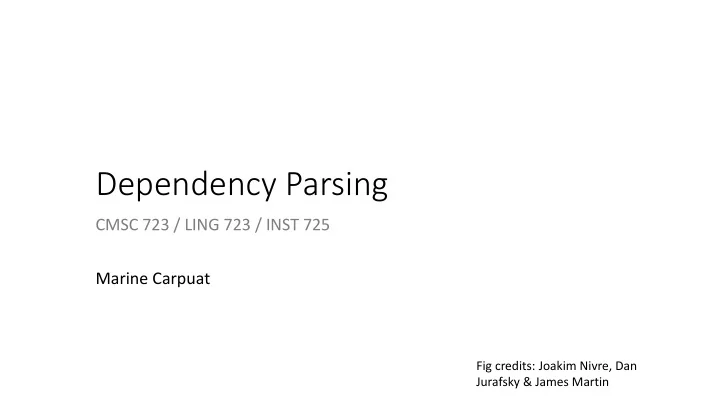

Dependency Parsing CMSC 723 / LING 723 / INST 725 Marine Carpuat Fig credits: Joakim Nivre, Dan Jurafsky & James Martin
Dependency Parsing • Formalizing dependency trees • Transition-based dependency parsing • Shift-reduce parsing • Transition system • Oracle • Learning/predicting parsing actions
Dependency Grammars • Syntactic structure = lexical items linked by binary asymmetrical relations called dependencies
Dependency Relations
Example Dependency Parse They hid the letter on the shelf Compare with constituent parse… What’s the relation ?
Dependency formalisms • Most general form: a graph G = (V,A) • V vertices: usually one per word in sentence • A arcs (set of ordered pairs of vertices): head-dependent relations between elements in V • Restricting to trees provide computational advantages • Single designated ROOT node that has no incoming arcs • Except for ROOT, each vertex has exactly one incoming arc • Unique path from ROOT to each vertex in V • Each word has a single head • Dependency structure is connected • There is a single root node from which there is a unique path to each word
Projectivity • Arc from head to dependent is projective • If there is a path from head to every word between head and dependent • Dependency tree is projective • If all arcs are projective • Or equivalently, if it can be drawn with no crossing edges • Projective trees make computation easier • But most theoretical frameworks do not assume projectivity • Need to capture long-distance dependencies, free word order
Data-driven dependency parsing Goal: learn a good predictor of dependency graphs Input: sentence Output: dependency graph/tree G = (V,A) Can be framed as a structured prediction task - very large output space - with interdependent labels 2 dominant approaches: transition-based parsing and graph-based parsing
Transition-based dependency parsing • Builds on shift-reduce parsing [Aho & Ullman, 1927] • Configuration • Stack • Input buffer of words • Set of dependency relations • Goal of parsing • find a final configuration where • all words accounted for • Relations form dependency tree
Transition operators • Transitions: produce a new • Start state configuration given current • Stack initialized with ROOT node configuration • Input buffer initialized with words in sentence • Dependency relation set = empty • Parsing is the task of • Finding a sequence of transitions • End state • That leads from start state to • Stack and word lists are empty desired goal state • Set of dependency relations = final parse
Arc Standard Transition System • Defines 3 transition operators [Covington, 2001; Nivre 2003] • LEFT-ARC: • create head-dependent rel. between word at top of stack and 2 nd word (under top) • remove 2 nd word from stack • RIGHT-ARC: • Create head-dependent rel. between word on 2 nd word on stack and word on top • Remove word at top of stack • SHIFT • Remove word at head of input buffer • Push it on the stack
Arc standard transition systems • Preconditions • ROOT cannot have incoming arcs • LEFT-ARC cannot be applied when ROOT is the 2 nd element in stack • LEFT-ARC and RIGHT-ARC require 2 elements in stack to be applied
Transition-based Dependency Parser • Assume an oracle • Parsing complexity • Linear in sentence length! • Greedy algorithm • Unlike Viterbi for POS tagging
Transition-Based Parsing Illustrated
Where to we get an oracle? • Multiclass classification problem • Input: current parsing state (e.g., current and previous configurations) • Output: one transition among all possible transitions • Q: size of output space? • Supervised classifiers can be used • E.g., perceptron • Open questions • What are good features for this task? • Where do we get training examples?
Generating Training Examples • What we have in a treebank • What we need to train an oracle • Pairs of configurations and predicted parsing action
Generating training examples • Approach: simulate parsing to generate reference tree • Given • A current config with stack S, dependency relations Rc • A reference parse (V,Rp) • Do
Let’s try it out
Features • Configuration consist of stack, buffer, current set of relations • Typical features • Features focus on top level of stack • Use word forms, POS, and their location in stack and buffer
Features example • Given configuration • Example of useful features
Dependency Parsing • Formalizing dependency trees • Transition-based dependency parsing • Shift-reduce parsing • Transition system • Oracle • Learning/predicting parsing actions
Recommend
More recommend